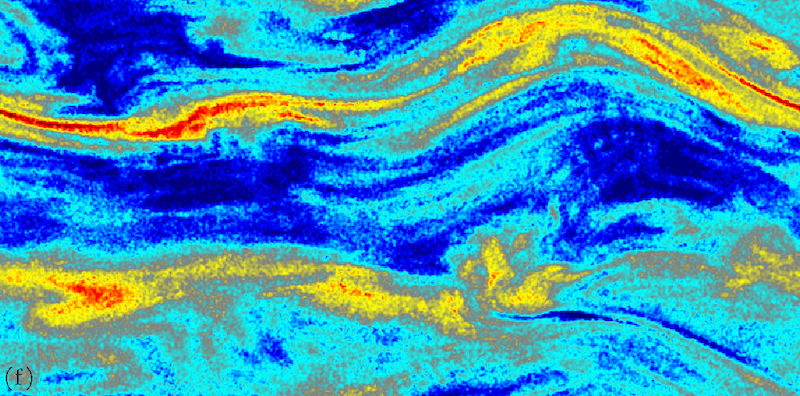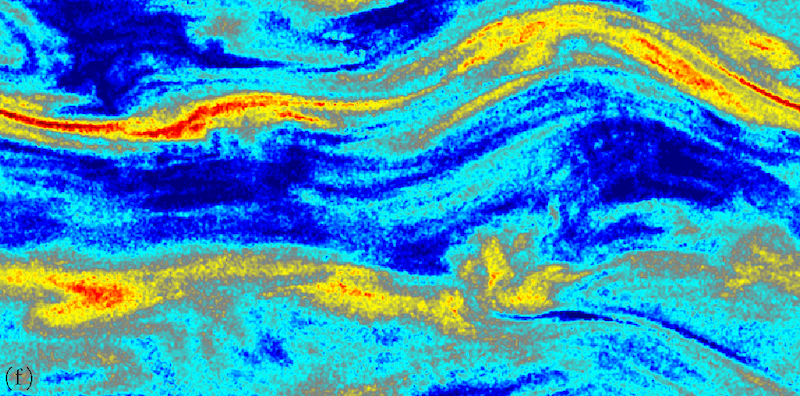Turbulence in Collisionless Cosmic Plasmas
Most of the regular matter in the Universe is plasma, an ebullient state characterized by charged particles interacting collectively with electromagnetic fields. When individual particles collide on scales much shorter than those of bulk plasma motions, the latter are described well by a 3D fluid theory: magnetohydrodynamics. That condition prevails in the interiors of stars and planets and in protoplanetary accretion disks. But many hot, low-density astrophysical plasma flows are only weakly collisional. Accounting for stellar winds, accretion around black holes, and the motions of the plasma that pervades intergalactic space requires a statistical kinetic description of the particle positions and velocities in a 6D space. Numerical simulations by Lev Arzamasskiy of the Institute of Advanced Study in Princeton, New Jersey, and his colleagues [1] shed new light on magnetized kinetic turbulence in such plasmas. They also pave the way for coarse-grained descriptions of plasma dynamics at the large scales that astronomers observe.
Cosmic fluids are subject to powerful processes that drive fluid motions on large scales, such as accretion onto a neutron star or nuclear fusion inside a main-sequence star. Whether a flow is laminar or turbulent depends on viscosity, which in a gas is proportional to the particles’ mean free path. Where particle collisions are frequent, the viscosity is usually too low for viscous friction to dissipate energy on large astronomical scales. Instead, the energy cascades down to much smaller scales, where viscous strains ultimately dissipate it into heat. This turbulent, nonlinear dynamical response of a fluid to a lack of equilibrium on large scales is the principal vehicle for the macroscopic transport and mixing of key physical quantities, such as entropy in stars or angular momentum in accretion flows. It therefore regulates the energetics and evolution of many cosmic systems.
By contrast, individual particles in collisionless cosmic plasmas carry momentum over long distances. Such plasmas do not necessarily have low viscosities. Can they even be turbulent? Unlike collisional fluids, collisionless plasmas host wave-particle resonances and suffer kinetic instabilities that scatter and trap particles in electromagnetic fluctuations. These all impede particle trajectories, endowing the plasma with an effective collisionality. How kinetic dynamics affects thermalization, microscopic (collisional), and large-scale (turbulent) transport processes is a fundamental problem of enormous importance and extreme complexity.
Researchers in magnetically controlled fusion have long sought to characterize the many transport processes that prevent efficient confinement of hot plasma [2]. But only recently has a phenomenological picture of turbulence in cosmic plasmas emerged. Although cosmic plasmas usually contain much less magnetic energy than their fusion counterparts, their low collisionality ensures that the radius of gyromotion in the magnetic field remains tiny compared to the collisional mean free path. Large-scale plasma stirring in cosmic plasmas leads to the development of pressure anisotropies relative to the dynamically evolving magnetic field, which in turn feed fast kinetic instabilities [3]. The latter, which are well-known in heliospheric plasmas [4], excite strong electromagnetic fluctuations on microscopic scales that, by scattering particles, provide a degree of effective collisionality on larger scales [5].
Simulating a system that exhibits extreme multiple-scale nonlinearity requires high-performance computing. However, 6D cosmic plasmas belong in a numerical complexity class of their own. The work of Arzamasskiy and colleagues is a tour de force in this respect. The authors performed high-resolution particle-in-cell kinetic simulations of the collisionless version of a classic fluid problem—magnetohydrodynamic turbulence—using a staggering 1011 macroparticles.
Their analysis of the particles’ dynamics revealed that two key effects alter the fluid picture. The first is collisionless damping, a wave-particle resonant process first theorized in 1946 by Lev Landau by which wave energy, contained in large-scale magnetic Alfvén waves, is transferred to particles. The second effect is the particle scattering by nonlinear pressure-anisotropy-driven microscale instabilities—dominated by an instability similar to the writhing of a pressured firehose—that develop on top of the evolving Alfvén waves. Although this scattering generates some plasma collisionality, the measured effective viscosity remains large, so that the turbulent cascade is somewhat curtailed. Hence, weakly magnetized collisionless plasmas indeed appear to be harder to render turbulent.
The results of Arzamasskiy and his collaborators are relevant to several outstanding astrophysics problems. For instance, the thin, hot plasma within a galaxy cluster radiates energy away so efficiently that it should cool and collapse toward the center of the cluster’s gravitational well. But it doesn’t. The particles and photons hurled into the plasma by a cluster’s central dominant galaxy may cause just enough turbulence for dynamical thermalization to counter a cooling collapse [6].
Despite recent progress, magnetized plasma turbulence has only just started to yield its mysteries to researchers. For computational reasons, Arzamasskiy and colleagues and others have focused on the collisionless dynamics of ions while treating the electrons as a fluid. In fact, the lighter, collisionless electrons in hot, dilute cosmic plasmas are also subject to similar kinetic processes but on even smaller scales. Researchers have barely started to touch on this electron-scale dynamics, which has its own key implications for magnetic generation, reconnection, radiation, and heat and charge transport [7, 8].
Another major challenge is to bridge the gap between kinetic simulations like those of Arzamasskiy and colleagues and magnetohydrodynamic simulations of cosmological structure formation or black hole accretion. Modeling astrophysical systems from their largest scales to electron scales is impossible: in the intracluster medium, the scales span 14 orders of magnitude. Nevertheless, kinetic simulations and their accompanying analyses such as that of Arzamasskiy and colleagues are invaluable. They make it possible to devise physically motivated models that encapsulate the net transport effects of microscale physics on fluid scales without having to simulate the full kinetics [9]. It is now up to the community to seize these results to further advance our broader astrophysical understanding.
References
- L. Arzamasskiy et al., “Kinetic turbulence in collisionless high-𝛽 plasmas,” Phys. Rev. X 13, 021014 (2023).
- X Garbet et al., “Physics of transport in tokamaks,” Plasma Phys. Controlled Fusion 46, B557 (2004).
- A. A. Schekochihin et al., “Plasma instabilities and magnetic field growth in clusters of galaxies,” Astrophys. J. 629, 139 (2005).
- D. Verscharen et al., “The multi-scale nature of the solar wind,” Living Rev. Sol. Phys. 16, 5 (2019).
- M. W. Kunz et al., “Firehose and mirror instabilities in a collisionless shearing plasma,” Phys. Rev. Lett. 112, 205003 (2014).
- I. Zhuravleva et al., “Turbulent heating in galaxy clusters brightest in X-rays,” Nature 515, 85 (2014).
- G. T. Roberg-Clark et al., “Suppression of electron thermal conduction by whistler turbulence in a sustained thermal gradient,” Phys. Rev. Lett. 120, 035101 (2018).
- I. Pusztai et al., “Dynamo in weakly collisional nonmagnetized plasmas impeded by Landau damping of magnetic fields,” Phys. Rev. Lett. 124, 255102 (2020).
- J. F. Drake et al., “Whistler-regulated magnetohydrodynamics: Transport equations for electron thermal conduction in the high-𝛽 intracluster medium of galaxy clusters,” Astrophys. J. 923, 245 (2021).





